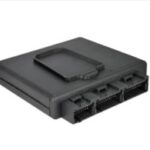Replacing an automotive alternator in a boat with a marine alternator often leads to wiring confusion. This article addresses common questions about Alternator Wiring Schematics, specifically focusing on upgrading to a marine alternator like the Sierra 18-5957, a popular choice for boat owners. Understanding the wiring is crucial for a successful installation and to ensure the charging system functions correctly.
This guide outlines the typical wiring configuration for a marine alternator, clarifies the function of the external voltage regulator, and provides insights into adapting the existing wiring harness for the new internally regulated alternator. The original setup used a Motorcraft automotive alternator with an external voltage regulator, connected via a blue wire. Other connections included a large battery cable to the solenoid, an orange wire to the carburetor’s choke assembly, and a grey ground wire.
With the new Sierra 18-5957, the external voltage regulator becomes unnecessary as this alternator is internally regulated. The large BAT terminal connects directly to the battery positive via the solenoid. The ground terminal should be securely connected to the engine frame or a dedicated grounding point. This leaves two wires, a red and a black, emanating from a black plastic box on the alternator, whose function needs clarification. These wires likely connect to the ignition switch and provide a sensing mechanism for the alternator to determine battery voltage and adjust its output accordingly. One common configuration uses the red wire for sensing voltage and the black wire as a ground for the voltage regulator circuitry within the alternator.
Consult the Sierra 18-5957’s documentation for the precise wiring diagram, as different manufacturers might use varying color codes and configurations. Typically, marine alternator wiring diagrams specify connections for the battery (B+), ignition (IGN), and ground (GND). Some alternators also include a warning light (L) terminal for indicating charging system issues.
Bypassing the external voltage regulator simplifies the wiring. Disconnect the blue wire previously connected to the regulator. The orange wire connected to the carburetor choke might need reevaluation. This connection potentially supplied a 12V source to the electric choke when the ignition was on. With the new alternator, this functionality needs to be ensured. If the new alternator lacks a dedicated provision for this, consider adding a relay triggered by the ignition switch to power the choke.
The grey ground wire from the old alternator should connect to the ground terminal on the new Sierra alternator. Ensuring a clean, solid ground connection is paramount for optimal alternator performance and preventing electrical issues. Double-check all connections for tightness and proper insulation to avoid shorts or other problems.
In conclusion, understanding the alternator wiring schematic is critical when upgrading to a new marine alternator. While the basic principles remain consistent, consulting the manufacturer’s wiring diagram for the specific model is crucial. This guide offers a foundational understanding to aid in a successful installation process. Always prioritize safety and consult with a qualified marine technician if you encounter difficulties or uncertainties.
